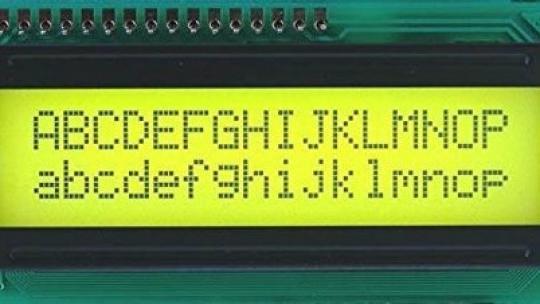An onsite explanation would help. Something glowing right next to the gumball machine.
The default: 16x2 Liquid Crystal Display (LCD). This yellowish green window is how hacked-together electronics communicate with the world.
There's not a lot of room for expression on one of these devices: just 2 lines of text, 16 characters each.
Most of the time, that's enough: an LCD like this is usually displaying:
- Machine talk -- data from a sensor or circuit board; or
- A terse message from a hacker to him- or herself: a small, hopeful prayer that things are working -- that circuits are making round trips.
Paste an image of one of these LCDs in Google Image Search, and it will return screenfuls of cascading, glowing rectangles, conveying messages that hopeful experimenters are sending to themselves.
Very often: "hello world;" but also, "Is this working?"
A few years ago you'd see, "All your base are belong to us."
Also common: meta self descriptions: stating the model and/or brand of LCD in the picture:
"This is a 2x16 line LCD display."
Also a lot of alphabets and numerals: A-Z; 1- 10.
The overall message: "Test, Test. Is this working?"
In the real world, you see these displays on inexpensive coffeemakers, cameras, and electronics. They are a foreboding that you're going to have to work through a menu with only four inputs: arrows n,s,e,w.
Below, a short, truncated scroll of a much longer search result from Google.

You can get these LCDs from Chinese suppliers for $3 each; $2.75 each if you order more than 500.
You bought yours from Sparkfun, located outside Boulder, Colorado. It came with a "backpack" that smoothed out some of the interface issues.
So, officially, it's a SparkFun Serial Enabled 16x2 LCD - Black on Green 3.3V.
Here's what it looks like on the back:

After it arrived in the mail, you took it directly to Cambridge Hackspace on the very next Tuesday drop-in night.
Then you tried to send a message to the LCD: from my computer > the Particle cloud > a Photon > the LCD.
Nothing.
Was it the LCD? The computer/cloud connection? The Particle Photon?
You are getting nowhere... until a young man with a strong Russian accent sits down next to you, curious about the LCD and the splayed wires.
He is well-dressed. As you both look down at the project you noticed that he is wearing black leather shoes that come to stylish points.
He (you never got his name; he didn't mentioned it) said he was at the Hackspace to work with an MIT-based team on an upcoming robot competition. When he examined the LCD and the Photon, he said that it should work.
Now he was engaged. He began to work on the code in Particle's integrated development environment (IDE) with an intensity that bordered on righteous anger.
Slowly, the LCD succumed: text messages began flickering on the screen: first sporadically, then more consistently as he adjusted the wiring and the code. All this took about 12 minutes.
By the time he returned to his robot project, you are sending tiny, tentative messages.
Unfortunately, they looked like messages on your coffeemaker.
Let's just say they didn't pop. They seem, in fact, to recede... back to the 1970s.
So you start looking around for something more... Times Square.
